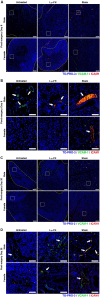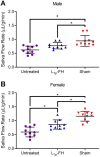Sex-dependent Regeneration Patterns in Mouse Submandibular Glands
- PMID: 32391739
- PMCID: PMC7226622
- DOI: 10.1369/0022155420922948
Sex-dependent Regeneration Patterns in Mouse Submandibular Glands
Abstract
Our previous studies indicated that YIGSR-A99 peptides chemically conjugated to fibrin hydrogel (FH) and applied to wounded submandibular gland (SMG) in vivo, formed new organized salivary tissue, whereas wounded SMG treated with FH alone or in the absence of a scaffold showed disorganized collagen formation and poor tissue healing. While these studies indicated that damaged SMG grow and differentiate when treated with FH containing L1 peptide, they were performed only in female mice. However, there is a well-established sexual dimorphism present in mouse SMG (e.g., males develop well-differentiated granular convoluted tubules, but these structures are poorly developed in females) and little is known about how these sex differences influence wound healing events. Therefore, the goal of this study was to conduct comparative analyses of regeneration patterns in male and female mice using L1p-FH in a wounded SMG mouse model. Particularly, we focused on sex-dependent wound healing events such as macrophage polarization, vascularization, tissue organization, and collagen deposition, and how these events affect salivary gland functioning.
Keywords: gender differences; materials science; regeneration; saliva; salivary physiology.
Conflict of interest statement
Figures





References
-
- Pinkstaff CA. Salivary gland sexual dimorphism: a brief review. Eur J Morphol. 1998;36:31–4. - PubMed
-
- Kurabuchi S, Da JT, Gresik EW, Hosoi K. An unusual sexually dimorphic mosaic distribution of a subset of kallikreins in the granular convoluted tubule of the mouse submandibular gland detected by an antibody with restricted immunoreactivity. Histochem J. 1999;31(1):19–28. - PubMed
-
- Denny PC, Denny PA. Dynamics of parenchymal cell division, differentiation, and apoptosis in the young adult female mouse submandibular gland. Anat Rec. 1999;254(3):408–17. - PubMed
Publication types
MeSH terms
Substances
Grants and funding
LinkOut - more resources
Full Text Sources
Miscellaneous

